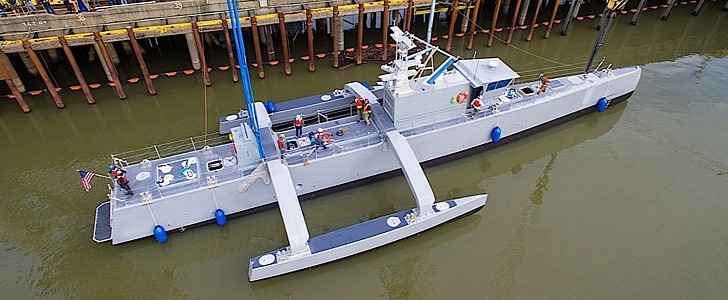Unmanned technologies are, without a doubt, the future of warfare. That’s been diligently proven over in Europe, where the Ukrainian army is making short work of Russian machines of war using drones.
Although generally the word drone is associated with flying assets, there are such machines made to work in other environments as well. Maritime drones, and even large, uncrewed ships, are presently at the center of the U.S. Navy’s focus, as it seeks to integrate this kind of hardware into its fleet.
A testimony to the importance naval unmanned vessels are about to get is the establishment of the first Navy dedicated unit. Called Unmanned Surface Vessel Division (USVDIV) One, it was born in the family of the U.S. Pacific Fleet at the end of last week.
To be led by Cmdr. Jeremiah Daley, the new division is meant to “accelerate the delivery of credible and reliable unmanned systems in conjunction with increasingly capable manned platforms into the fleet,” as the man himself said.
The unit will be a sort of testbed for such machines, and will experiment both with them and ways to integrate them into the fleet. For now, we’re told of just two ships that were included in the division, the Sea Hunter and sister ship, the Sea Hawk.
The Sea Hunter was introduced in 2016, and was constructed by a company called Vigor Industrial. It is 132 feet (40 meters) long, has a displacement of 135 tons, and can move about for 12,000 miles (19,000 km) on a single outing.
The ship moves in autonomous mode by means computers, optical guidance and radar, which it uses to patrol an set area while avoiding obstacles. The ship was built in such a way as not to allow for constant human presence on board.
The Navy plans to use the Sea Hunter and its sister ship for anti-submarine and counter-mine missions, but we can easily imagine its successors fulfilling other roles as well.
A testimony to the importance naval unmanned vessels are about to get is the establishment of the first Navy dedicated unit. Called Unmanned Surface Vessel Division (USVDIV) One, it was born in the family of the U.S. Pacific Fleet at the end of last week.
To be led by Cmdr. Jeremiah Daley, the new division is meant to “accelerate the delivery of credible and reliable unmanned systems in conjunction with increasingly capable manned platforms into the fleet,” as the man himself said.
The unit will be a sort of testbed for such machines, and will experiment both with them and ways to integrate them into the fleet. For now, we’re told of just two ships that were included in the division, the Sea Hunter and sister ship, the Sea Hawk.
The Sea Hunter was introduced in 2016, and was constructed by a company called Vigor Industrial. It is 132 feet (40 meters) long, has a displacement of 135 tons, and can move about for 12,000 miles (19,000 km) on a single outing.
The ship moves in autonomous mode by means computers, optical guidance and radar, which it uses to patrol an set area while avoiding obstacles. The ship was built in such a way as not to allow for constant human presence on board.
The Navy plans to use the Sea Hunter and its sister ship for anti-submarine and counter-mine missions, but we can easily imagine its successors fulfilling other roles as well.






